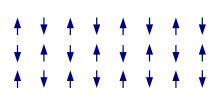This article needs additional citations for verification. (May 2014) |

| Condensed matter physics |
|---|
 |
In materials that exhibit antiferromagnetism, the magnetic moments of atoms or molecules, usually related to the spins of electrons, align in a regular pattern with neighboring spins (on different sublattices) pointing in opposite directions. This is, like ferromagnetism and ferrimagnetism, a manifestation of ordered magnetism. The phenomenon of antiferromagnetism was first introduced by Lev Landau in 1933.[1]
Generally, antiferromagnetic order may exist at sufficiently low temperatures, but vanishes at and above the Néel temperature – named after Louis Néel, who had first in the West identified this type of magnetic ordering.[2] Above the Néel temperature, the material is typically paramagnetic.
- ^ Landau, L. D. (1933). A possible explanation of the field dependence of the susceptibility at low temperatures. Phys. Z. Sowjet, 4, 675.
- ^ M. Louis Néel (1948). "Propriétées magnétiques des ferrites; Férrimagnétisme et antiferromagnétisme" (PDF). Annales de Physique. 12 (3): 137–198. Bibcode:1948AnPh...12..137N. doi:10.1051/anphys/194812030137. S2CID 126111103.